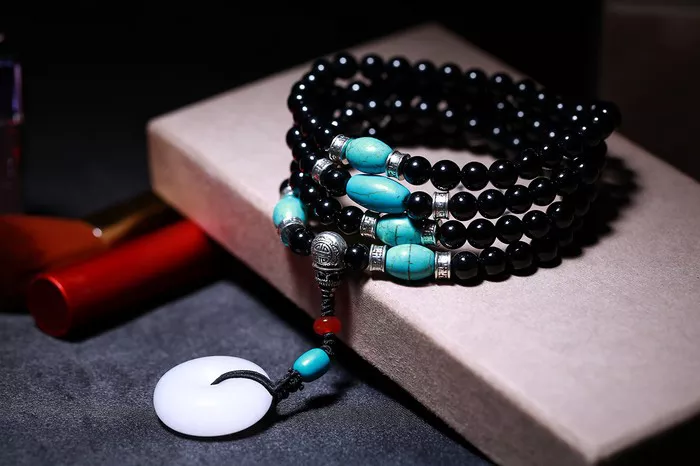Turquoise, with its captivating hues ranging from sky blue to deep green, has been cherished for centuries for its beauty and cultural significance. Revered by ancient civilizations and adorning modern jewelry collections alike, turquoise continues to captivate enthusiasts with its timeless allure.
Among the various forms of turquoise jewelry, one intriguing variant stands out: reconstituted turquoise. This article delves into the fascinating world of reconstituted turquoise jewelry, exploring its origins, manufacturing process, characteristics, and popularity.
Understanding Reconstituted Turquoise: Origins and Definition
Reconstituted turquoise, often referred to as “reconstituted stone” or “reconstructed turquoise,” is a synthetic material that mimics the appearance of natural turquoise. Unlike natural turquoise, which is formed through geological processes over millions of years, reconstituted turquoise is a product of human intervention.
The process of reconstituting turquoise involves grinding turquoise fragments or powder and combining them with a binding agent, typically epoxy resin or acrylic. This mixture is then compressed and shaped into desired forms, such as beads, cabochons, or intricate jewelry pieces. Once cured, the resulting material closely resembles natural turquoise in color and texture.
The Manufacturing Process: Art and Science in Harmony
Creating reconstituted turquoise jewelry involves a meticulous blend of craftsmanship and scientific precision. The process can be broken down into several key steps:
Raw Material Selection: High-quality turquoise fragments or powder are carefully chosen as the starting material. These fragments may come from various sources, including natural turquoise mines or recycled turquoise.
Grinding and Mixing: The turquoise material is ground into fine particles to ensure uniformity and smooth texture. It is then mixed with a binding agent, which serves to hold the particles together and provide stability.
Molding and Shaping: The mixed turquoise and binding agent are shaped into the desired form, such as beads, cabochons, or intricate jewelry components. This can be done using molds or by hand, depending on the complexity of the design.
Curing: The shaped turquoise mixture undergoes a curing process, during which the binding agent hardens and solidifies, forming a durable composite material.
Finishing Touches: Once cured, the reconstituted turquoise is polished and buffed to enhance its luster and smoothness. This final step brings out the inherent beauty of the material, making it ready for use in jewelry making.
Characteristics of Reconstituted Turquoise Jewelry
Reconstituted turquoise jewelry possesses several distinct characteristics that set it apart from its natural counterpart:
Color Consistency: Unlike natural turquoise, which can vary in color and intensity due to geological factors, reconstituted turquoise offers consistent coloration. This uniformity allows jewelry makers to create pieces with predictable aesthetics, ideal for matching sets or themed collections.
Affordability: Reconstituted turquoise is often more affordable than natural turquoise, making it accessible to a wider range of consumers. This affordability makes it an attractive option for both novice jewelry enthusiasts and seasoned collectors alike.
Durability: The binding agent used in reconstituted turquoise adds strength and resilience to the material, making it less prone to chipping or cracking compared to natural turquoise. This durability ensures that reconstituted turquoise jewelry maintains its beauty and integrity over time.
Versatility: Reconstituted turquoise can be molded and shaped into a variety of forms, allowing for endless design possibilities. From classic bead necklaces to intricate mosaic patterns, the versatility of reconstituted turquoise inspires creativity in jewelry making.
Ethical Considerations: While natural turquoise mining can have environmental and ethical implications, reconstituted turquoise offers a more sustainable alternative. By utilizing recycled turquoise or byproducts from natural mining processes, reconstituted turquoise minimizes the ecological footprint associated with traditional mining practices.
See Also: The Meaning of Reconstituted Turquoise
Popularity and Appeal of Reconstituted Turquoise Jewelry
Reconstituted turquoise jewelry has gained popularity among consumers for several reasons:
Aesthetics: The vibrant colors and natural patterns of reconstituted turquoise closely resemble those of natural turquoise, making it visually appealing to jewelry enthusiasts. Its consistent coloration and smooth texture enhance its aesthetic appeal, ensuring that each piece stands out as a work of art.
Affordability: As mentioned earlier, reconstituted turquoise is more affordable than natural turquoise, making it an attractive option for budget-conscious shoppers. This accessibility allows individuals to enjoy the beauty of turquoise jewelry without breaking the bank.
Versatility: The versatility of reconstituted turquoise lends itself to a wide range of jewelry styles and designs. Whether incorporated into bohemian-inspired accessories or elegant statement pieces, reconstituted turquoise adds a touch of sophistication to any ensemble.
Sustainability: In an era where environmental consciousness is paramount, reconstituted turquoise offers a sustainable alternative to traditional mining practices. By repurposing existing turquoise materials or byproducts, reconstituted turquoise minimizes the environmental impact associated with turquoise production.
Cultural Significance: Turquoise has deep cultural significance in many societies, symbolizing wisdom, protection, and spiritual enlightenment. Reconstituted turquoise jewelry allows individuals to connect with this rich cultural heritage while expressing their personal style.
Conclusion:
In conclusion, reconstituted turquoise jewelry represents a harmonious blend of artistry and science, offering a captivating alternative to natural turquoise. Through meticulous craftsmanship and innovative manufacturing techniques, artisans create stunning pieces that capture the essence of turquoise’s timeless allure.
With its consistent coloration, affordability, durability, and versatility, reconstituted turquoise jewelry continues to enchant consumers around the world. Whether worn as a fashion statement or cherished as a cultural keepsake, reconstituted turquoise jewelry stands as a testament to humanity’s creativity and reverence for the natural world.
As the demand for sustainable and ethically sourced materials grows, reconstituted turquoise is poised to remain a beloved choice for jewelry enthusiasts seeking beauty, quality, and conscientiousness in their adornments. In a world where art and science converge, reconstituted turquoise shines as a beacon of innovation and inspiration in the realm of jewelry making.


